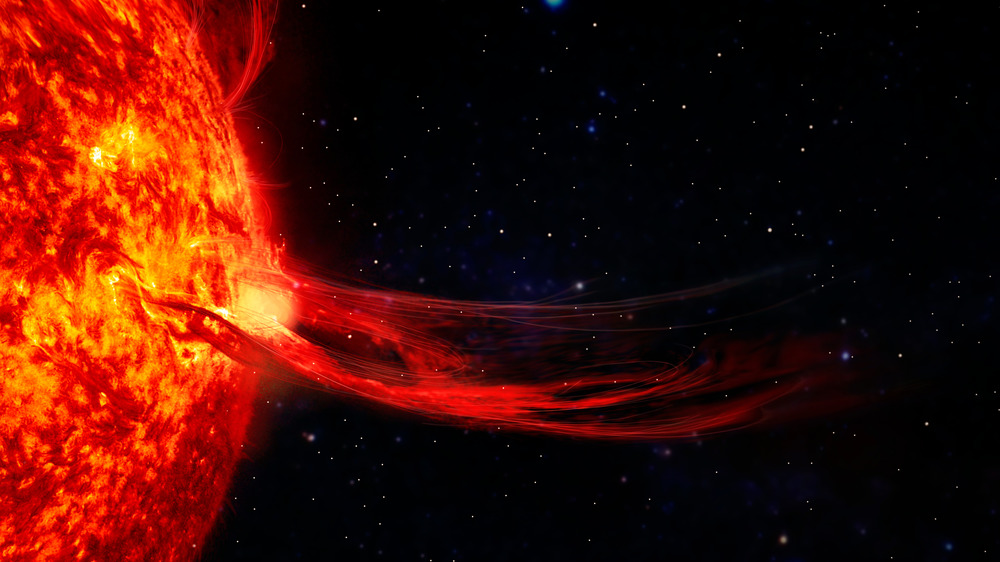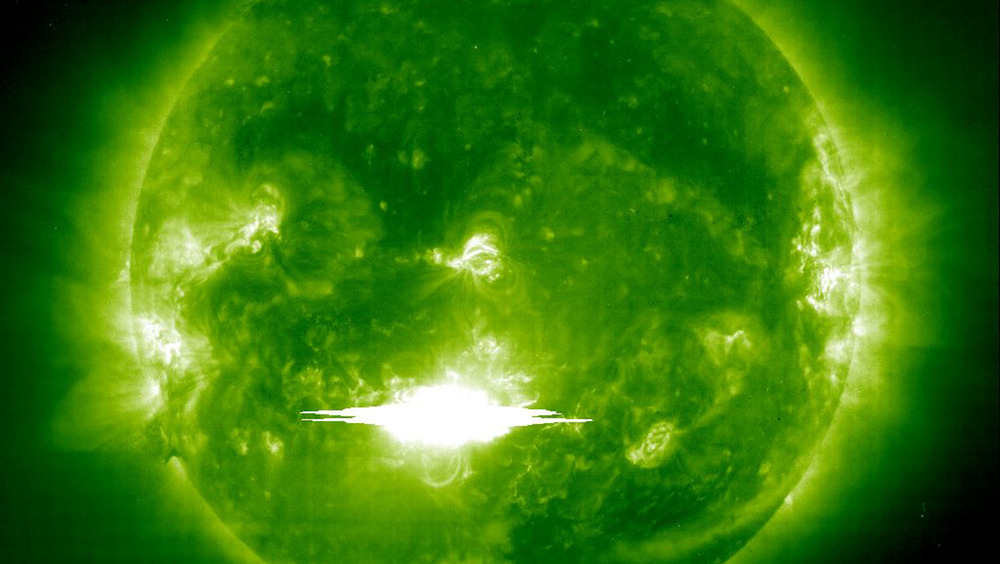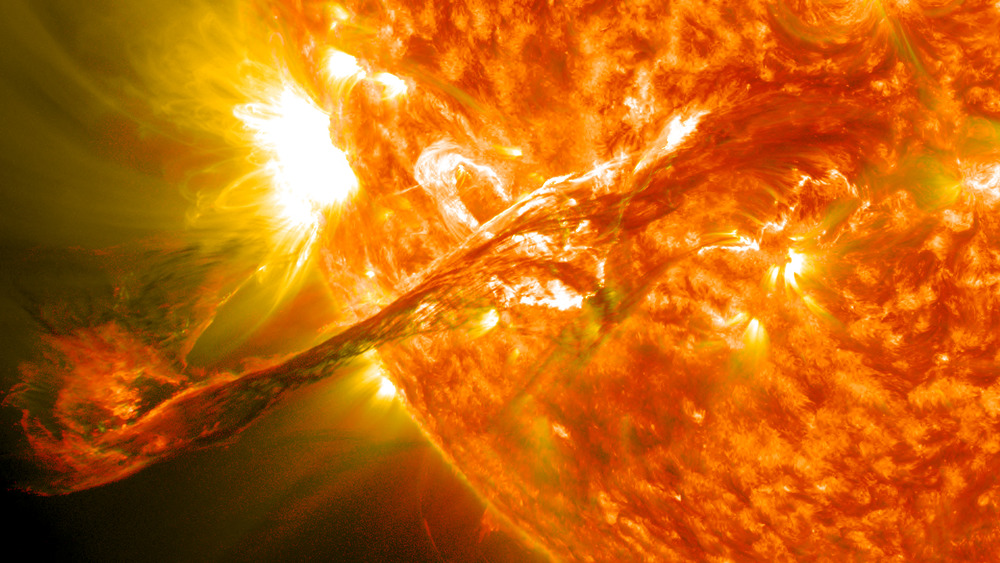The Chilling Truth About Solar Storms
The Sun is a wonderful thing. It provides the Earth's organisms with the energy and warmth we need to survive. But, while enabling life, the Sun can also bring disaster. And no, we're not referring to the Sun's eventual explosion in a few billion years, but something that happens right now: solar storms.
As you probably know, the Sun is a giant ball of tremendously hot plasma. With such a chaotic system, disturbances are bound to erupt — and they do, often. Per NASA, these disturbances are referred to as "solar storms" and they come in a variety of forms, from solar flares to coronal mass ejections. In general, solar storms involve large amounts of plasma being ejected from the surface of the Sun out into space. That plasma is typically accompanied by magnetic fields and radiation in the form of high-energy particles.
Basically, solar storms are massive explosions that shoot out from the Sun, which is awesome. But what's less awesome is what happens when those ejections collide into Earth. This doesn't happen all that often — at least not from large solar storms — but when it does, the effects can be devastating. From radiation illness to widespread power outages, solar storms bring invisible destruction from above. The worst part? We never know when the next one might hit.
To start, solar storms can carry health risks. Energetic solar storms send out harmful radiation.
A massive solar flare could wipe out the entire electrical grid
Thankfully, most of this radiation is deflected by the Earth's atmosphere, but the exposure is more intense the higher up you are. Per Eos, plane passengers would receive around 90 to 110 microsieverts of radiation in the event of a strong solar storm — about as much as an X-ray exam, which isn't too bad. The real radiation risk would be for aircraft crew, who spend more time in the sky, and for the astronauts living above Earth's atmosphere.
Besides that, one of the worst things about solar storms is their effect on the power grid. Per New Scientist, powerful solar flares can completely wipe out many aspects of our crucial electrical infrastructure. That's especially the case for systems that require satellites, like GPS and the internet. But it's also true for ground-based power grids and everything that relies on them, from computers to household appliances to the cooling systems for nuclear reactors. Having to live without the internet (even for a day) would be horrible; we can all agree that widespread nuclear meltdown would be much worse.
This isn't just a hypothetical scenario. Power-grid-destroying solar storms have actually happened. In March of 1989, reports NASA, a large cloud of electrically-charged solar plasma hit Earth, leaving most of Quebec without power for half a day. The solar storm cost an estimated $13.2 million in damages, per one study, posted at Research Gate.
An 1859 solar storm was the biggest on record, and messed with the telegraph system
That 1989 electrical outage is a grim example of the devastating power of solar storms. But things could have been worse. Much worse.
In 1859, The Conversation reports, the Earth was hit by the biggest solar storm ever recorded. (Our records only go back as far as the 1800s, though.) Now called the "Carrington Event," for the first astronomer to record it, it involved a massive blob of solar plasma striking into the Earth. While a normal amount of solar wind produces the so-called "Northern Lights," the 1859 storm produced an aurora that could be seen as far south as the Caribbean.
The storm was a beautiful sight for many. But to telegraph operators, it was a headache, causing telegraphs to send off shocks whenever they were touched. Fed up, many telegraph operators chose to unplug their machines. That's when things got really weird. Per Wired, there was so much electricity in the air that the telegraphs continued to work even after being unplugged — sometimes even better than before.
Today, we're far more reliant on electronics than the average citizen of 1859, so a solar storm of the same magnitude would have a tremendously devastating effect. Per New Scientist, if the Carrington Event were to happen today, it could cost around $10 trillion in damages. Even scarier: Some scientists estimate there's a 12 percent chance a storm of that size could hit Earth within a decade.
Solar storms are the largest explosions in the solar system
It's also terrifying to consider just how enormously powerful solar storms are. According to NASA, the strongest ("X-class") solar storms "can produce as much energy as a billion hydrogen bombs." That's an insane amount of energy, making solar storms the largest explosions in the entire solar system (by far).
Besides being powerful, solar storms are also fast. Per EarthSky, coronal mass ejections typically take about three or four days to reach the Earth from the Sun. But that can vary greatly; 1859's massive solar storm took just 17 hours to reach the Earth. If that were to happen again, humanity would have very little time to prepare for a solar storm's effects after first detecting it.
Overall, the worst part about solar storms is how unpredictable they are. We have no idea when the next solar storm will hit Earth, nor how intense it will be. All we have is a rough sense of how common they are — and NASA suggests that they're getting noticeably more common as the Sun continues to age. What can be done to stop solar storms from hitting Earth? Not much, unfortunately. As New Scientist writes, some astronomers have proposed launching an enormous loop of conductive wire between Earth and the Sun to stop the storms from reaching us, but that likely won't happen any time soon, if ever. For now, all we can do is wait and hope for the best.



